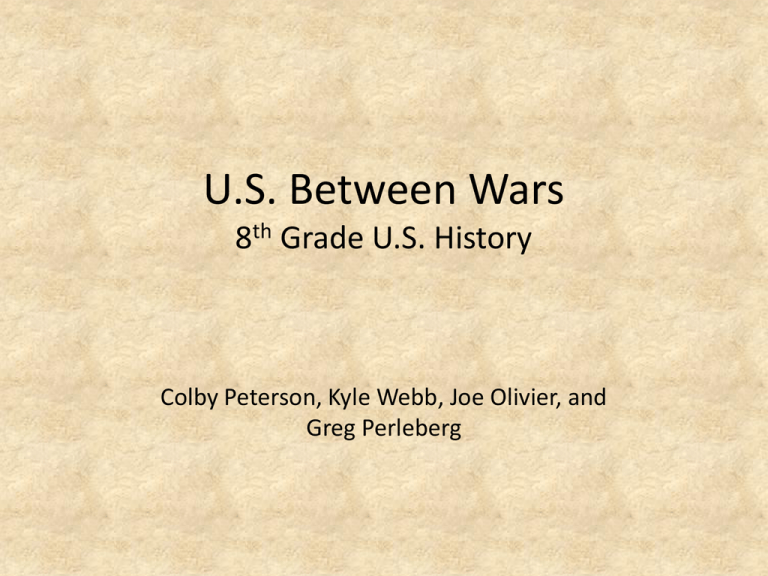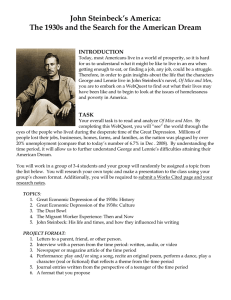US Between Wars - SDSU
advertisement

U.S. Between Wars 8th Grade U.S. History Colby Peterson, Kyle Webb, Joe Olivier, and Greg Perleberg Order of Things • The unit will be done in a chronological order. We will start with life post World War I and work gradually to the start of World War II. The unit, using block scheduling teaching a class for 90 minutes every other day, will take 3 ½ weeks of instruction. Unit Rationale • It is important to learn and understand the economic, social, and political changes that occurred in this short span of time. Today’s society has been shaped by what occurred in this time period, and it is critical to see what happened between two of the most memorable wars in history. Essential Questions • Why is this unit important? • What led to the Stock Market crash of 1929? Why was it important in society? • What were some of the social and economic changes that occurred between World War I and World War II? • What legacy did FDR leave behind? Was the New Deal successful? What effects did it have on the country? • What was the Dust Bowl? Why is it memorable? What were its societal and psychological effects? Unit Objectives • SWBAT formulate reasoning for changes in society during the 1920s and 1930s. • SWBAT list problems Americans faced during the Great Depression and Dust Bowl. • SWBAT gather a feeling of empathy for the people living through the depression after such a prosperous decade. • SWBAT understand how developments from this era have had a lasting impact on society. • SWBAT analyze and know the difference between primary and secondary sources. NCSS Themes • 2) Time, Continuity, and Change – Studying the past makes it possible for us to understand the human story across time. The historical experiences of societies, peoples and nations reveal patterns of continuity and change. • 3) People, Places, and Environments – The study of people, places, and environments enables us to understand the relationship between human populations and the physical world. Students learn where people and places are located and why they are there. They examine the influence of physical systems, such as climate, weather and seasons, and natural resources, such as land and water, on human populations. They study the causes, patterns and effects of human settlement and migration, learn of the roles of different kinds of population centers in a society, and investigate the impact of human activities on the environment. • 4) Individual Development and Identity – Personal identity is shaped by an individual’s culture, by groups, by institutional influences, and by lived experiences shared with people inside and outside the individual’s own culture throughout her or his development. • 8) Science, Technology, and Society – Science, and its practical application, technology, have had a major influence on social and cultural change, and on the ways people interact with the world. 1920s (Week 1) • Spend one week covering the 1920’s up to the Stock Market Crash of 1929. – Life Post WWI & Jazz Age. With this day we will talk to students about proper ways to research for a paper as well as how to cite sources. – Prohibition, Political Stances, Teapot Dome, Harding’s Death – Societal changes leading up to the Stock Market Crash Early 1930s (Week 2) • Causes of the Great Depression • Election of 1932 Mid 1930s (Week 3) • New Deal Programs, Fireside Chat, Increased Role of the First Lady • Life in the Great Depression, Dust Bowl • Research Day for Papers/Assessment 1930s (Week 4) • 1st half of class time - Review of the Unit • 2nd half of class time- Present Papers (½ with teacher, ½ with principle) Unit Assessment • Students will write a 2 ½- 3 page research paper over one of the topics presented in the unit. Time will be designated at the beginning of the unit to tell students how to effectively research topics and show how to read and understand primary documents.







